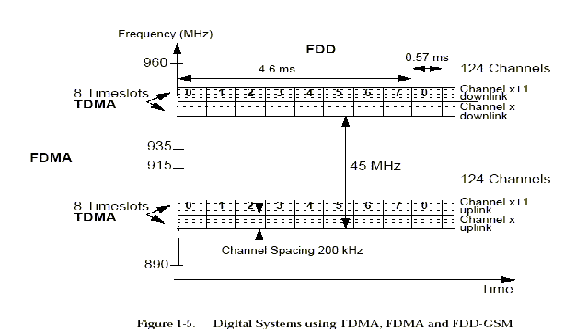GSM Characteristics
Overview technical characteristics:
Main technical characteristics of the GSM
system are:
· Radio frequency spectrum used:
- for P-GSM-900: 890 - 915 MHz and 935 - 960 MHz
- for E-GSM: 880 - 915 MHz and 925 - 960 MHz
- for R-GSM: 876 - 915 MHz and 921 - 960 MHz
- for GSM-1800: 1710 - 1785 MHz and 1805 - 1880 MHz.
The GSM Standards E-GSM and R-GSM bands include the primary frequencies.
It depends on the current radio frequency spectrum usage in a specific
area whether the extension can be used.
· Use of FDD (Frequency Division Duplexing),
FDMA (Frequency Division Multiple Access) and TDMA (Time Division
Multiple Access) techniques
· Digital cellular system
GSM radio frequency spectrum:
In the frequency range specified for GSM-900 System mobile radio
networks, 124 frequency channels with a bandwidth of 200 KHz are
available for both the uplink and downlink direction. The uplink
(mobile station to BTS) uses the frequencies between 890 MHz and
915 MHz and the downlink (BTS to mobile station) uses the frequencies
between 935 MHz and 960 MHz. The duplex spacing, the spacing between
the uplink and downlink channel, is 45 MHz. The E-GSM band adds
50 frequency channels and the R-GSM another 20 frequency channels
to the spectrum. For the specific channel number to frequency mapping
refer to the table
on the next page.
In the frequency range specified for GSM-1800 System mobile radio
networks, 374 frequency channels with a bandwidth of 200 KHz are
available for both the uplink and downlink direction. The uplink
uses the frequencies between 1710 MHz and 1785 MHz and the downlink
uses the frequencies between 1805 MHz and 1880 MHz. The duplex spacing
is 95 MHz.
Multiple access techniques:
In cellular and cordless terminology the three main types of multiple
access used to divide the radio frequency spectrum between the cell
site radios and the mobile stations are:
· Frequency Division Multiple Access (FDMA):
Each call is carried on a separate frequency channel.
· Time Division Multiple Access (TDMA):
Each frequency channel is further divided into a set of timeslots;
each timeslot carries the data of a voice call.
· Code Division Multiple Access (CDMA):
A spread-spectrum technology is used, in which the radio signals
associated with a call are spread across a single broad frequency
spectrum (1.25 MHz). Each call in the spectrum is differentiated
from other calls in that spectrum by assigning a unique code to
each call's signal. At the receiving end (mobile station or cell
site), the specific call's signal is isolated by decoding the full
received signal using the code assigned to that call's signal.
Multiplexing techniques:
The two multiplexing techniques used in cellular and cordless terminology
are:
· Frequency Division Duplexing
(FDD)
In FDD two symmetric frequency bands are used, one containing the
uplink channels and the other the downlink channels.
· Time Division Duplexing (TDD)
TDD means that the uplink of the voice call is time multiplexed
on the same frequency channel as the downlink of the voice call.
Techniques used in GSM:
In the GSM system, TDMA in combination with FDMA is used; the usage
of each radio channel is partitioned into multiple (eight) timeslots,
and each user is assigned a specific frequency/ timeslot combination.
Thus, only a single mobile is using a given frequency/timeslot combination
at any particular time.
Also the FDD technique is in use, that is two symmetric frequency
band, one band containing the uplink channels and the other the
downlink channels.
Analog cellular systems - AMPS:
In the AMPS system, FDD in combination with FDMA is used. A total
of 50 MHz in the bands 824-849 MHz and 869-894 MHz is allocated
to cellular mobile radio. This spectrum is divided into 832 frequency
channels, each 30 kHz wide. Frequency modulation (FM) is used for
speech channels, and Frequency Shift Keying (FSK) for signaling
channels. This way of sharing spectrum is called Frequency Division
Multiple Access (FDMA).

Digital Cellular Systems
- IS-95:
The EAI/TIA IS-95 standard is based on the CDMA system. In CDMA
a spread spectrum technology is used, in which the radio signals
associated with a call are spread across a single broad frequency
spectrum (1.25 MHz). Each call in the spectrum is differentiated
from other calls in that spectrum by assigning a unique code to
each call's signal. At the receiving end (mobile station or cell
site), the specific call's signal is isolated by decoding the full
received signal using the code assigned to that call's signal. All
other noises or signals with calls that do not match the assigned
code are ignored.
The CDMA frequency access method allows the
service provider to reuse the same frequencies in adjacent cells.
This is because an assigned code is used to decipher the signals,
therefore signals in the same frequency but with a different code
appear as noise to the receiving end. Reuse of the same frequency
in adjacent cells, along with other reasons, allows CDMA to provide
a capacity improvement over the FDMA and TDMA access methods. Though
FDMA and TDMA do allow radio frequencies to be reused, the separation
between cells containing the same frequency must be far enough so
that co frequency interference can be kept below acceptable levels
most of the time. Frequencies are organized into cell clusters for
TDMA and FDMA and their sizes are determined by the number of cells
per cluster and the radius per cell. With CDMA the service provider
can reuse all frequencies (in the spread spectrum mode) in all cells.
Another major benefit of a CDMA system is the ability of a CDMA
Mobile Station to communicate to more than one Cell at one time
during a call. This functionality, known as a Soft-Handoff, provides
a seamless uninterrupted call while the Mobile Station moves between
Cells.
|
